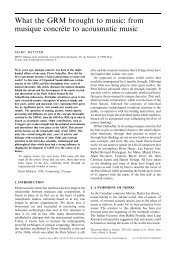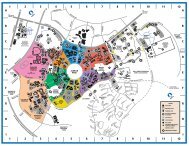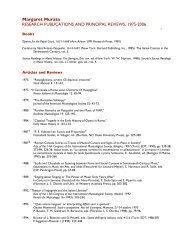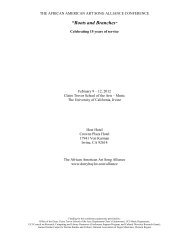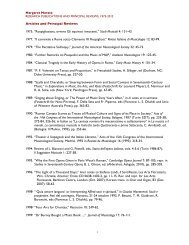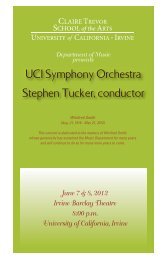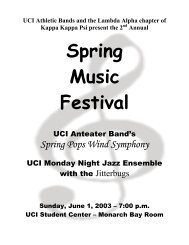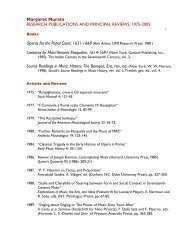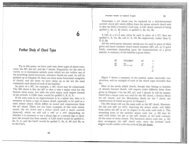3D motion capture data: motion analysis and mapping to music
3D motion capture data: motion analysis and mapping to music
3D motion capture data: motion analysis and mapping to music
You also want an ePaper? Increase the reach of your titles
YUMPU automatically turns print PDFs into web optimized ePapers that Google loves.
ody part can be used as a threshold <strong>to</strong> parse the <strong>motion</strong> of the<br />
body part in<strong>to</strong> different segments. This will then create a way<br />
for interpreting gestures that is tied more <strong>to</strong> the quality of the<br />
gesture, rather than <strong>to</strong> the spatial location of the body part.<br />
The method focuses on <strong>data</strong> from the <strong>motion</strong> of a single<br />
marker observed using the Vicon system (in our example, this<br />
is the right finger marker). The first step is <strong>to</strong> try <strong>to</strong> find<br />
transition points, where the point begins <strong>to</strong> move, s<strong>to</strong>ps, or<br />
significantly changes direction (Fig.3). These transitions points<br />
can be used <strong>to</strong> break long sequence of continuous <strong>data</strong> in<strong>to</strong><br />
shorter gestural segments, each of which can be used <strong>to</strong><br />
generate a single event <strong>to</strong> control a <strong>music</strong>al process.<br />
<strong>motion</strong>s made by the dancer. Although these do not seem <strong>to</strong> be<br />
initially very significant, calculating the velocity <strong>and</strong><br />
acceleration from these slightly noisy functions greatly<br />
increases the noise, as can be seen from the figure below. The<br />
filtering was accomplished by simply calculating a running<br />
average with the last few frames of the <strong>data</strong> (we used around<br />
10). We found the most effective way <strong>to</strong> remove this noise was<br />
<strong>to</strong> both preprocess the position information, as well as filter the<br />
subsequent function prior <strong>to</strong> edge detection. The coefficients<br />
of these functions are very important for the effectiveness of<br />
the edge detection, <strong>and</strong> can be found through either careful<br />
tuning, or through machine learning, if transition points have<br />
been previously determined by h<strong>and</strong>.<br />
Figure 3. An example of a transition point.<br />
The raw <strong>data</strong> is in the form of three floating point coordinates<br />
(x, y, z) for each frame of the <strong>motion</strong> <strong>capture</strong> <strong>data</strong>. This <strong>data</strong><br />
delineates a 3-dimensional vec<strong>to</strong>r function of time. In order <strong>to</strong><br />
use st<strong>and</strong>ard edge detection techniques, <strong>and</strong> in order <strong>to</strong> remove<br />
bias <strong>to</strong>ward particular directions (we want a <strong>motion</strong> parallel <strong>to</strong><br />
an axis <strong>to</strong> have the same effect as one askew <strong>to</strong> the axes), we<br />
needed <strong>to</strong> reduce this function in<strong>to</strong> a single scalar function of<br />
time. We first calculated the first derivatives with respect <strong>to</strong><br />
time of each <strong>data</strong> point, obtaining the velocities along the three<br />
axes. A fringe benefit of this transformation was also the<br />
removal of a preference <strong>to</strong> a particular location or point of<br />
origin in the <strong>data</strong>. Through experimentation, we found that<br />
there was a strong correlation between the transition points we<br />
were looking for <strong>and</strong> an increase in the acceleration of the<br />
point (intuitively, this is related <strong>to</strong> the kinesthetic muscle<br />
response by the dancer <strong>to</strong> change the trajec<strong>to</strong>ry of the marker).<br />
Although it is possible <strong>to</strong> generate points from sudden<br />
increases in velocity, we found it more useful <strong>to</strong> base our<br />
points on increases in acceleration. This way sudden halts <strong>and</strong><br />
abrupt changes in direction could be also interpreted as<br />
transition points, along with the beginnings of a <strong>motion</strong>. A<br />
single scalar function was then generated by taking the second<br />
derivative of the position <strong>and</strong> obtaining the scalar magnitude<br />
by taking the dot product of the vec<strong>to</strong>r with itself.<br />
A crucial step in the processing of this function is the use of<br />
low pass filtering <strong>to</strong> eliminate jitter. A good deal of small<br />
variation in the <strong>data</strong> is found due <strong>to</strong> both small inaccuracies in<br />
acquiring the measurements, as well as "haptic noise" in the<br />
Time <br />
Figure 4. 1D <strong>analysis</strong> from <strong>motion</strong> <strong>capture</strong> <strong>data</strong>: Low Pass<br />
Filtered x component of position (Upper Left), Magnitude<br />
of <strong>3D</strong> Velocity (Upper Right), Magnitude of <strong>3D</strong><br />
Acceleration (Lower Left), Acceleration Low Pass Filtered<br />
with leading edges marked (Lower Right).<br />
Once we had obtained a single function vs. time, we could then<br />
use st<strong>and</strong>ard edge detection techniques <strong>to</strong> parse the transition<br />
points. The two st<strong>and</strong>ard methods for finding edges are either<br />
1) <strong>to</strong> calculate the Laplacian (in 1 dimension, just the second<br />
derivative of time) <strong>and</strong> find the zero points, or 2) find local<br />
maxima <strong>and</strong> minima by looking at increases <strong>and</strong> decreases in<br />
the first derivative with respect <strong>to</strong> time [11]. We found the<br />
second method <strong>to</strong> be the most expedient, <strong>and</strong> found that the<br />
transition point we were looking for corresponded <strong>to</strong> troughs in<br />
the function. We then found the leading edge of each peak by<br />
looking for the first significant increase in the function<br />
subsequent <strong>to</strong> a significant decrease.<br />
Once the transition points have been found, <strong>and</strong> the <strong>motion</strong> has<br />
been parsed in<strong>to</strong> gestural segments, a number of parameters<br />
that characterize the segments can be very easily extracted<br />
from them. A non-exhaustive list of these include: the time<br />
taken <strong>to</strong> traverse the segment, the <strong>to</strong>tal distance traversed over<br />
the segment, the average speed while traveling along the<br />
segment, <strong>and</strong> the "curviness" of the path (the relation of the<br />
<strong>to</strong>tal distance traveled divided by the direct distance between<br />
the end points). These parameters can then be augmented, if



